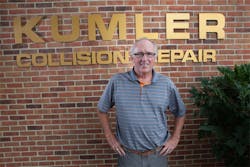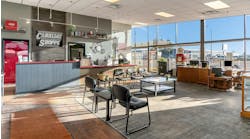In 1978, Dean DeRolph was chomping at the bit to get hired at Kumler Collision & Automotive in Lancaster, Ohio.
He really wanted to work at the shop and learn the business. Owner Keith Kumler hired DeRolph for $2.10 an hour, and the two became instant friends and business partners. Seven years later, DeRolph bought part of the company and they grew it together from ten employees and $1.5 million in sales each year to 34 employees and $5.5 million in annual revenue.
But on July 4, 1999, Kumler died in a boating accident. DeRolph and the shop lost a friend, a leader and a respected businessman.
“I was devastated emotionally,” he says. “Not only did I lose my best friend, but I lost a guy whose name was on the front of the building.”
DeRolph quickly had to figure out how to run the shop alone and maintain the momentum he and Kumler had built together.
THE BACKSTORY
Kumler and DeRolph balanced each other out when they were working together. DeRolph worked as a technician, production manager and estimator, while Kumler managed the finances and met with insurers. DeRolph was aggressive and constantly championed growth. He motivated the more conservative Kumler, who kept DeRolph in check. They were also close friends.
“We were like brothers,” he says. “It was a partnership. We just trusted each other. We were always on the same page. We worked together and we played together.”
When Kumler died, insurers told DeRolph that he needed to let customers know that the shop was still in business, continuing to offer the high-quality service that it had previously.
THE PROBLEM
DeRolph’s ambition was a strength working alongside Kumler. But working alone, it nearly ruined him.
He began working 12 hours a day, seven days a week. He became involved in daily operations of every single part of the business. He continued his work as an estimator, production manager and technician. He also took over managing the finances, working with more than 15 DRPs, and making decisions about everything from equipment purchases to training.
At the same time, he tripled advertising to 3 percent of sales. Six months after Kumler’s death, the shop began an advertising campaign that explained to the city of 37,000 that it was still dedicated to the community, to quality repairs and to training employees through organizations including I-CAR and ASE. In newspaper ads, DeRolph listed all of the employees and their years of service. Much of his staff had been with him since he came on in 1978.
He says he put in all the extra effort because he was scared of losing business.
“I went into panic mode,” he says. “I thought I had to be everything to everybody.”
At first the extra effort reaped results. In 2000, the shop saw nearly 20 percent growth in sales. But in 2001, he says, the shop hit a financial wall. Revenue didn’t grow at all.
He started talking to shop staff about why that would be happening. His employees pointed out that he was so busy that sometimes he wasn’t available for technicians, painters or customer service representatives to ask basic questions.
He realized he was micromanaging everything, and that what he was doing was not sustainable.
“I was exhausted,” he says. “I was so tired I couldn’t even think.”
THE OPTIONS
A couple of years after Kumler’s death, a consolidator caught wind of DeRolph’s situation and thought he might be interested in selling the operation.
DeRolph considered the option and sat down with the interested company, which was excited about the shop’s 50 percent market share. The consolidator’s representatives began talking about completing efficiency studies in the shop and restructuring it. They said some employees would make the cut, and some wouldn’t.
That’s when DeRolph woke up. He had considered selling the business, but immediately changed his mind when he heard staff would be cut. He cared more about the shop and the people than the financial benefits he might get from selling. The shop had never laid off a worker in its history, he says, and he wasn’t about to let that change on his watch.
He only saw one other path: He had to completely revamp the way he ran his business to continue as an owner, grow the shop, and keep his staff employed.
“It was really the best thing that had ever happened to me,” he says. “From that day on, I began to focus on how I take care of these people.”
THE DECISION
One of the first things DeRolph began doing was delegating more. His shop staff got on board, and some of them offered to take care of decisions that DeRolph had been making. For example, technicians began deciding who would repair which vehicles, and how. If they needed more training or new equipment like MIG welders, they figured it out on their own.
“Let us run with these things,” DeRolph recalls them saying.
The Experts Weigh InJim Siegfried
Owner, Crystal Lake Automotive
Lakeville, Minn.
Owner, Tehachapi Collision Center
Tehachapi, Calif.
Accounts and Marketing Manager, Trubilt Collision Center
Eau Claire, Wis.
As he stepped away from daily operations, he began working more on the business rather than in it. He started talking to peers in his 20 Group, and talking to other shop operators about their best practices.
Several people recommended he read Michael Gerber’s The E-Myth: Why Most Businesses Don’t Work and What to Do About It. He learned about the importance of having a systems-driven organization. He realized he had gone wrong with making all the business and shop decisions personally, rather than putting a standard operating procedure in place and empowering employees to make decisions off of those standards.
After that he began revamping the shop in numerous ways.
He appointed team leaders who handle what he used to handle by himself. He has a service manager, a production manager, a paint department manager, and customer service representatives who also work as estimators and handle files from beginning to end. He has people who are in charge of frame equipment, welding supplies and shop supplies. He has people who take care of and maintain all of the equipment so it’s updated and working properly.
“We are extremely organized and structured now,” DeRolph says.
They began talking more as a team, meeting each day to discuss the status of every vehicle. When cycle time decreased and revenue grew, they would talk as a group about why that happened, and what if anything they could do to keep improving. “I have a more coaching and teaching position now,” he says.
He also remembered an article he had come across in Inc. magazine several years earlier. It resonated so well with him that he had it laminated. The article explored how employees will treat customers however managers treat the staff. The author, who had also written about lean processes, emphasized how important it is to empower employees at every level.
Keeping with that intention, DeRolph created employee incentives. His employees are paid hourly, and the incentives are based on various accomplishments. For example, technicians can get a $1,200 bonus each year if they don’t foolishly damage a part. They also get monthly bonuses based on productivity and customer service index scores. They get five paid sick days per year, but they can get a $1,000 check at the end of the year if they don’t use them.
As all of this happened, DeRolph got out into the community more, which is something that he and Kumler both used to do together. He joined the local rotary club, got on the board of his local United Way, and became more involved with his church.
THE AFTERMATH
DeRolph says he saw an almost immediate impact on the shop after the changes. Net profit grew from 5 percent to 7 percent, and total sales grew about 10 percent from the year before. The shop cut cycle time from nine days to five and a half. Touch time improved from 1.7 hours per repair per day to 3.3 hours.
He says he noticed a huge culture change. He’ll see clusters of guys talking together, helping each other out on the best way to repair or paint a vehicle. He sees more brainstorming. They have an increased sense of responsibility, and ultimately, satisfaction.
“Morale’s always been good, but it’s really good now,” he says.
He says people have taken on much more responsibility. DeRolph says he can now take an entire week off and not notice a difference. He doesn’t even call the shop when he’s away. He says it’s important for them to know that he knows they do a great job and can run the shop without him.
“I respect them and know they can take care of it while I’m gone,” he says.
THE TAKEAWAY
DeRolph learned that a team truly is better than any individual. His staff can certainly do more together than he could do on his own.
“The difference is, instead of doing everything, I became a cheerleader,” he says.
His employees know what they need to do, and they take the responsibility to work on their own as well as together.
He’s feeling more relaxed than he’s ever felt. He spends more time talking to employees about their families and lives outside of work. He can sense that his mood rubs off on his staff, which helps everyone.
He’s glad he decided not to sell, and to work smarter instead of harder.
“I’m happier than I’ve ever been. I wish my partner was still here; that was fun,” he says. “But I’m happy.”




